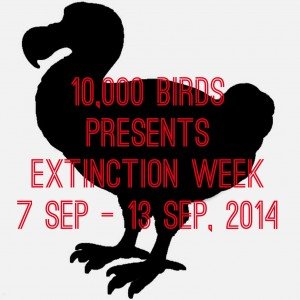
Passenger Pigeon. Kioea. Broad-billed Parrot. Alaotra Grebe. Saint Helena Cuckoo. Grand Cayman Thrush. Ascencion Crake. Kakawahie.
What do the eight birds above have in common? They are all extinct. They all went extinct since 1500 and they are only eight of the nearly two hundred species that have blinked out since then. Of those nearly two hundred there are very few that people would recognize. Most existed on small islands far from major population centers. Others are only known from a specimen or two sitting in the drawer of a research institution. They are all as dead as a Dodo but they don’t even have the dignity of being remembered.
Olson’s Petrel. Viti Levu Scrubfowl. Maupiti Monarch. Kona Grosbeak. Ryukyu Woodpigeon. Mauritius Night-Heron. North Island Snipe. Guam Flycatcher.
Eight more birds. Eight that I had never heard of. And, yeah, they’re all extinct too. It is horrible, this listing of names. This dirge for the extinct. How can we stand it? How can we continue to drive cars? Fly in airplanes? Drink coffee? Eat beef? Keep cats outdoors?
What right do we have to even exist when our very existence as humanity is what has caused a rate of extinction not seen except during cataclysmic events? And it is a rate of extinction that is speeding up! Sure, we try not to introduce snakes, rats, cats, goats, pigs, and a host of other creatures to isolated islands. But non-natives, and seriously damaging ones, are still constantly being introduced around the world. Most people oppose large-scale, indiscriminate, hunting of birds but it still happens all over the world. We recognize that climate change is going to radically alter ecosystems but we sure aren’t doing anywhere near enough to prevent it.
Huia. Mauritius Owl. Black-fronted Parakeet. Canary Islands Oystercatcher. Pagan Reed Warbler. Mysterious Starling. Pila’s Palila. Amsterdam Duck.
Writing about extinct birds is invariably depressing, especially for a birder. Birders like to see birds, especially ones that they have never seen. For there to be birds that can never be seen because they no longer exist is the height of frustrating. And that is the least of it. There are many birds that I will never see. I can live with that. No one has seen them all. But that there are birds that no one will ever see again, ever, well…I feel like I should use lots of strong language here. But, really, I don’t have the energy for it. Here, eight more names.
Spoon-billed Sandpiper. Iquitos Gnatcatcher. Raso Lark. Chinese Crested Tern. Siberian Crane. Djibouti Francolin. Mariana Crow. Liberian Greenbul.
The eight species above still exist. But they are all Critically Endangered. Some have tiny ranges. Others have populations in the double digits. They all face threats. They all won’t survive, especially without massive, long-term efforts dedicated to keeping them from going extinct.
And that is why we are having Extinction Week here on 10,000 Birds. It’s been one hundred years since the Passenger Pigeon went extinct, an extinction that was totally unimaginable even fifty years earlier. Now, we know what is happening. We know what can happen. And if we continue to do nothing more and more species will continue to blink out. To stop existing. To go the way of the Dodo, the Great Auk, the Huia. Extinction is forever. Let’s try not to let it happen anymore, shall we?
…
Extinction is forever. A species, wiped off the earth, never to exist again. What a horror! What a disaster! What a wrong!
 It is correct, of course, to think of extinction this way during the Holocene Extinction, which we are living through right now. After all, the extinctions have occurred, are occurring, and will occur because of us, people. We have so altered the earth – pumping pollution, moving species around, destroying ecosystems – that many species, dependent upon ecological niches or simply unprepared for an onslaught of unfamiliar organisms with which they did not evolve, have no chance. It is depressing and angering and just wrong.
It is correct, of course, to think of extinction this way during the Holocene Extinction, which we are living through right now. After all, the extinctions have occurred, are occurring, and will occur because of us, people. We have so altered the earth – pumping pollution, moving species around, destroying ecosystems – that many species, dependent upon ecological niches or simply unprepared for an onslaught of unfamiliar organisms with which they did not evolve, have no chance. It is depressing and angering and just wrong.
But, in the wider view of things, extinction is necessary. It is what drives evolution. Extinction is what befalls the species that fails to adapt, to survive, to thrive. Most species go extinct. That is just the hard, cold reality of nature, red in tooth and claw.
This is not to say that we should sit back and let the Holocene Extinction continue. No! We must fight to save every species we can, every ecosystem, every niche.
It is the 100th anniversary of the extinction of the Passenger Pigeon, once one of the most abundant species in the world. In order to raise our awareness, to remind us of what we have lost, and to inspire us to fight for Every. Single. Species. we are hosting Extinction Week here on 10,000 Birds from 7 September to 13 September. Come back, click through, read, learn. And get angry and take action.
…













A bluebird has been flying into my window all week. He was fluttering into my French doors in my back patio doors. Now he is fluttering into my front window. Can someone tell me why?
Hi Corey,
I know I’m late in commenting here, but I wanted to thank you for keeping these extinct birds in our minds.
Do you know what efforts (if any) are being made to prevent any of those endangered birds from going extinct?
Looking forward to hearing about any info you have on that.